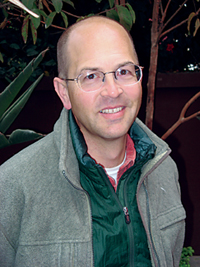What is it that tourists seek in Nepal? And, how is it that the Nepalese are so good at attracting tourists to come?
These are two of the questions that anthropologist Mark Liechty is pursuing as a Fulbright Senior Research Scholar in Nepal this winter.
 Mark Liechty is an Associate Professor of Anthropology and History at the University of Illinois at Chicago. He has had a long association with Nepal. He attended Woodstock School in Mussoorie, north India, in the late 1960s, and first visited Nepal as a nine-year old boy with his parents in 1969. One of the things he is doing now is trying to connect with some of what he missed here at that young age. In the late 1970s he was again a student at Woodstock (where he graduated in 1978) while his parents worked with the United Mission to Nepal (UMN), giving him more time to explore this country. Following high school he attended Goshen College in Indiana, then studied anthropology at the University of Pennsylvania. He chose anthropology because he wanted a career that would bring him back to this part of the world. While he likes India (“It’s a nice place to visit”, he says), he prefers Nepal.
Mark Liechty is an Associate Professor of Anthropology and History at the University of Illinois at Chicago. He has had a long association with Nepal. He attended Woodstock School in Mussoorie, north India, in the late 1960s, and first visited Nepal as a nine-year old boy with his parents in 1969. One of the things he is doing now is trying to connect with some of what he missed here at that young age. In the late 1970s he was again a student at Woodstock (where he graduated in 1978) while his parents worked with the United Mission to Nepal (UMN), giving him more time to explore this country. Following high school he attended Goshen College in Indiana, then studied anthropology at the University of Pennsylvania. He chose anthropology because he wanted a career that would bring him back to this part of the world. While he likes India (“It’s a nice place to visit”, he says), he prefers Nepal.
He came again as a university student in the late 1980s. At that time he wanted to pursue research on some aspect of medical anthropology in Nepal. He soon discovered, however, how many had done just that ahead of him. So he switched gears, and became interested in studying Kathmandu’s emerging middle class society instead. He got that idea while working at a UMN-sponsored drug rehabilitation center. While there, he began to ask what life means to Nepal’s middle-class youth. And, why drugs? In 1991, funded by a Fulbright scholarship, he launched into a larger study of middle class consumer culture. After completing his PhD dissertation, he published what he found out in a book entitled Suitably Modern: Making Middle Class Culture in a New Consumer Society (Princeton University Press, 2003).
Now Mark is back again, this time pursuing the history of tourism between 1950 and 1980, and the relationship between Nepalis and tourists. He finds it interesting, for example, to see when and how Nepal shows up, historically, as a tourist destination. “And, why Nepal?” he asks. One thing he has found is that many tourists arrive in Nepal with pre-figured notions of what to look for, and what to expect. Many seek the exotic and the mystical (and drugs, in the days when ‘Freak Street’ was a popular destination). While some have come for adventure others are lured by a certain romantic image of the place and the people. More than one Westerner arriving for the first time has been heard to say: “It looks just like what I saw in National Geographic magazine.” At this, he wonders, “What other pre- images are there? Where do they come from? How do tourists get them? And, how do they change over time?”
For part of the answer he is examining how Nepal has been depicted in popular media (magazines, newspapers and film) and how certain images and perceptions have made Nepal unique—e.g., the Sherpas and Mount Everest, Gurkha soldiers, the abominable Yeti, and the ‘Lost Horizons’ image associated with Nepal as a modern-day Shangri-la.
Mark is equally impressed by and interested in how well Nepalese entrepreneurs ‘sell’ foreigners what they come looking for. Over the years many have sought dharma and mysticism and hashish, great food and adventure trekking. “The Nepalese figured that out,” he says, “better than anywhere else in South Asia. They’re very skilled at learning what tourists expect, want and need. That’s partly why Nepal holds a special place as a destination in the minds of tourists”, he concludes, “over India, for example.”
I asked Mark what changes he has seen in Nepal over the years. “Much,” he remarked, then described one impression he had recently while driving back from Dhulikhel in the dark. “There were so many lights,” he said. “Everywhere. Lights. There’s no more countryside left. It seems to be all settled.”
Mark Liechty would love to hear your stories about the early history of Nepal tourism. He can be reached by email at: liechty@uic.edu.










